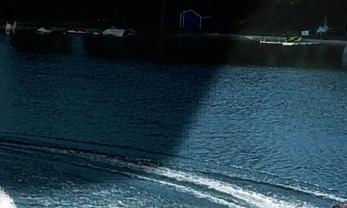
4 minute read
PRESERVING A GEM | FROM 3B
impacts on lake levels under control.
During high water levels, flooding and shoreline erosion increase. During low water levels, docks and piers are high and dry, navigation is hindered and recreation is diminished. The root cause of low water levels is overuse of groundwater.
Advertisement
Drinking water for the community surrounding White Bear Lake comes from groundwater. Four wells ranging from 476 to 970 feet deep draw water from the Prairie Du Chien-Jordan, Jordan and Mount Simon aquifers. The water coming out of these wells continues to be safe for drinking. The concern is keeping water in the aquifers.
Keeping our lake healthy
In May of 1971, the WBLCD was founded by an act of the Minnesota Legislature to address modern era concerns.
Later, we became unsure that the lake would always be clean enough to drink from and its fish safe to eat.
Still later, a new threat in the form of invasive species appeared. The WBLCD had plenty of work to do.
What exactly is a lake conservation district?
A lake conservation district is a governmental organization which manages a large lake at the local level, promoting the protection of natural resources and governing use of the lake.
While there are many types of conservation districts in Minnesota, such as the Washington County Conservation District and the Ramsey County Soil and Water Conservation District, there are only two lake conservation districts in the state, the WBLCD and the Lake Minnetonka Conservation District, or LMCD. These were created by the state Legislature to provide local governance on behalf the multiple municipalities that surround their respective lakes.
These special districts can enact ordinances separate from the ordinances of the municipalities surrounding the lake.
A lake conservation district differs from the lake associations that exist for more than 500 lakes in Minnesota. A lake association is a volunteer organization comprised of lakeshore homeowners and concerned community members which organizes conservation activities and advocates for environmental policies to protect their lake. A lake conservation district, on the other hand, is a governmental entity and is run much like a city or a school district with the same obligations. The district is required to set a balanced budget and has the ability to tax. The WBLCD is a member of the League of Minnesota Cities, just like cities throughout the state. The WBLCD and LMCD were created by the Minnesota Legislature and have been given authority to enforce their rules by contracting with law enforcement agencies and the DNR.
The WBLCD generally has authority from the lakeshore into the lake, while the municipalities retain authority over the land, outside the lake boundary, said WBLCD director Scott Costello. Rules set by a conservation district may be more restrictive than DNR rules, but not less, said WBLCD director Mark Ganz. For example, the DNR might say the maximum number of boats allowed in a certain marina is 100. The conservation district might limit that number to 80 boats, but could never allow more than 100 boats, he said. For more than 50 years, the WBLCD has been working on its mission to preserve White Bear Lake for future generations.
Meetings
7 p.m.
Third Tuesday of the month WBL City Hall Council Chambers
Eurasian watermilfoil and Zebra mussels
Eurasian watermilfoil (EWM) was first observed in 1988 with a single plant collected near a public dock on the west side of White Bear Lake. Each year, the WBLCD conducts a survey of Eurasian watermilfoil growth in the lake, sampling more than 700 sites. A treatment plan is created from the survey results and the EWM is treated with a DNR-approved herbicide.
Zebra mussels were first discovered in Fall 2014, the DNR declared White Bear Lake infested with naturally reproducing non-native zebra mussels.
The WBLCD launched a public information campaign in 2015 to update lakeshore owners. Recommendations to prevent Zebra mussels from spreading to other lakes can be found on the WBLCD website.
There is no treatment option for widespread infestation, only preventative measures to stop the spread. Zebra mussel populations are cyclical: If there's a lot of algae in the lake, the Zebra mussels thrive and the population increases. Once Zebra mussels eat all of the algae, the population decreases, until the algae levels increase again. The population seemed to peak around 2018.
Current threats
Starry stonewart, invasive Yellow Iris and Chloride pollution are current threats. See pages 6A to 7A to learn more.
WBLCD board
The 10-member volunteer WBLCD board of directors is made up of two directors from each city bordering the lake (White Bear Lake, White Bear Township, Dellwood, Mahtomedi and Birchwood). The cities appoint their representatives (directors) for a term of three years. Currently, the 10 directors are:
• Chair Bryan DeSmet, White Bear Township


• Vice Chair Meredith Walburg, Dellwood
• Secretary/Treasurer Mike Parenteau, White Bear Lake




• Director Mark Ganz, Mahtomedi

• Director Christopher Churchill, Mahtomedi
• Director Mark Wisniewski, Dellwood
• Director Scott Costello, White Bear Lake
• Director Diane Longville, White Bear Township



• Director Susie Mahoney, Birchwood

• Director Darren DeYoung, Birchwood
WBLCD meetings are held in the White Bear Lake City Hall Council Chambers at 7 p.m. on the third Tuesday each month, except for December.
The WBLCD's standing committees are: Lake Utilization Committee, Lake Quality Committee, Lake Education Committee, Lake Level Resolution Committee (active when the need arises). The committees offer positions for three members. Each position has a one-year term, from April to March, with applications accepted each February. Two representatives from the community are welcome on each committee.
The WBLCD has an abundance of information about the lake at www. wblcd.org. Contact the district by e-mail at: office@wblcd.org. Phone WBLCD Administrator Cheri Howe at (651) 429-8520. Follow the district on facebook at www.facebook.com/ WhiteBearLakeConservationDistrict.







